
HOME
INTRO
SYMBOLS
ALMANAC
ECONOMY
GEOGRAPHY
STATE MAPS
PEOPLE
FORUM
NEWS
COOL SCHOOLS
STATE QUIZ
STATE LINKS
BOOK STORE
MARKETPLACE
GUESTBOOK
CONTACT US


You may double left-click on a word on this page to retrieve its definition. Tweet Follow
New Hampshire State Vegetable
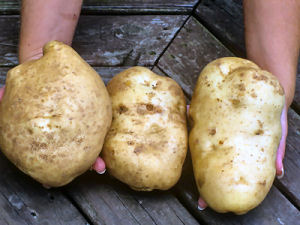
New Hampshire State Vegetable: White Potato
Prints, photographs, posters
It is generally understood that American potatoes originated in South America, specifically the countries now known as Peru and Bolivia.
Sometime in the 1600s, the migration of these vegetables began a long circuitous route that brought them first to Spain and then the broader European continent. The next stop for the potato was Great Britain. It was in Great Britain that the potato met the Scotch-Irish people who carried it to New Hampshire, to an area known at the time as Nutfield and now comprising Londonderry, Derry, and Windham.
The Derry Village School, located in Derry, New Hampshire, serves students from Kindergarten through fifth grade.
New Hampshire fourth grade curriculum includes a local history study unit. Immersed in their study of local history the Derry Village School fourth graders found that the white potato gained its first foothold in North America in New Hampshire. They discovered that it was a group of the Presbyterian Scotch-Irish settlers who brought the first seed potatoes to North America and planted them in the common field of the area known as Nutfield, now Derry. Rev. James MacGregor is often credited with carrying the "sack" of seed potatoes. The year was 1719.
Observing that New Hampshire had no official state vegetable, the students decided to remedy the situation.
Though the Commonwealth of Virginia had tried to take credit for the introduction of the potato in North America, the U.S. Potato Board substantiated New Hampshire's claim that the first cultivations took place in New Hampshire and Virginia conceded.
The Commissioner of Virginia wrote a letter to our state commissioner stating and I quote “According to the best information that we can find, the Irish potato did not come to Virginia until after your 1719 incorporation. We therefore concede to the Great State of New Hampshire, the honor of introducing to this country one of the great food crops.”
(O'Connor, "HB 535, establishing the white potato as the state vegetable.", 2013)
Research has confirmed, at this time, that the first seed potatoes were brought to North America and planted in Nutfield (Derry) in 1719.
This planting, according to historian Richard Holmes, the founder of the Derry Museum of History and a graduate of Keene State College, established the potato in North America.
(The Keene Sentinel, The Legislature may name an official state potato)
A historical symbol, the white potato seemed a fitting choice to join the state bird, the state wildflower, and the state fruit as an official representative of The Granite State.
Enlisted by the Derry Village School students and persuaded by their research and enthusiasm, State Representative John O’Connor (Derry) agreed to help them with their endeavor and submitted House Bill No. 535 proposing that the white potato be declared the "official state vegetable of New Hampshire." He praised the students for their efforts.
“They researched it and found out that we do not have a state vegetable,” O’Connor said, “and they researched it further and found that the very first potato grown in this great country of ours was grown in Derry, New Hampshire.”
Derry’s claim to the potato is supported by a state highway marker in the town, which says settlers in 1719 planted the Common Field, “where the potato was first grown in North America.”
(Derry representative, fourth-graders want potato to be N.H. state vegetable, 2012}
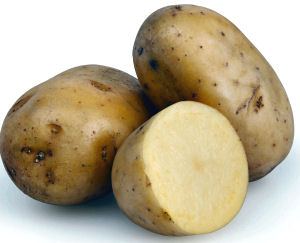
New Hampshire State Vegetable: White Potato
Submitted on January 3, 2013, House Bill No 535 was referred to the House Environment and Agriculture Committee for study and recommendation.
The potato met with little resistance in the House. Representative James Parison suggested that broccoli might be a better choice for the symbolic honor of official state vegetable. He called it the "the crown jewel of nutrition" [1] and, perhaps knowing better, suggested that if broccoli were the state vegetable, children might be more receptive to eating it. He called broccoli a "patriotic vegetable even though no one liked it until it became trendy in the 1930s." [1]
Parison's "patriotic vegetable" couldn't stop the progress of the white potato through the legislative process. House Bill No. 535 was approved by the House of Representatives by a vote of 276 to 75 in February 20, 2013.
The State Senate followed the lead of the House and approved of the white potato bill on May 2, 2013.
With the approval of the New Hampshire General Court, Governor Maggie Hassan indicated her intention to sign the bill.
“Gov. Hassan believes that the civic engagement displayed by Derry’s students in their efforts to pass this legislation reflects the best traditions of New Hampshire, and she looks forward to signing the bill into law,” spokesman Marc Goldberg said in a statement.
(Leubsdorf, "N.H. Senate backs potato but kills bills to decriminalize marijuana, ban prison privatization", 2013)
HB 535 – VERSION ADOPTED BY BOTH BODIES
2013 SESSION
13-03790
8/04STATE OF NEW HAMPSHIRE
In the Year of Our Lord Two Thousand Thirteen
AN ACT establishing the white potato as the state vegetable.
Be it Enacted by the Senate and House of Representatives in General Court convened:
1 New Section; State Emblems; State Vegetable. Amend RSA 3 by inserting after section 26 the following new section:
3:27 State Vegetable. The white potato is hereby designated as the official state vegetable of New Hampshire.
2 Effective Date. This act shall take effect 60 days after its passage.
On June 4, 2013, New Hampshire Governor Maggie Hassan signed House Bill No. 535 designating the white potato the state's official vegetable in the presence of the students who made it happen. The law went into effect sixty days later on August 3, 2013.
From South America to Europe to Great Britain to Nutfield, New Hampshire, the potato wore out several pairs of walking shoes to become the official state vegetable of the State of New Hampshire.
The states of Maine and Idaho have built strong reputations on the backs of their potato production and they have New Hampshire to thank.
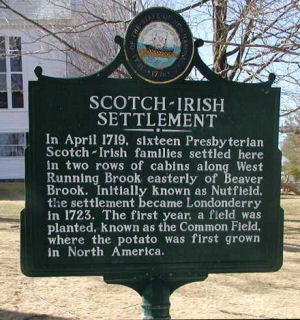
New Hampshire State Vegetable: White Potato
Highway Marker #58, East Derry Road
There is a highway marker that resides about a mile east of the Derry rotary on East Derry Road in front of the East Derry Church and site of the first meetinghouse. It commemorates the Scotch-Irish settlement specifically and refers to the white potato; "The first year, a field was planted, known as the Common Field, where the potato was first grown in North America."
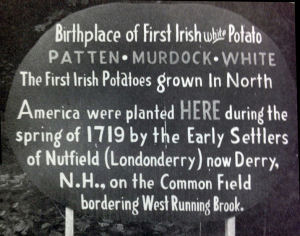
Common field commemoration sign... no longer present.
Back in 1962, after years of research, a sign was erected on the property of Mrs. Caroline Murdock White on the Route 28 by-pass in Derry by the Nutfield Grange of East Derry. It was placed to commemorate the common field where the first white potatoes were grown in American; "The Birthplace of First Irish White Potato'."
The Grange sign read " The First White Potato Patch in North America. Here, during the Spring of 1719, in a Common Field on the Murdock Homestead, near West Running Brook, the First Settlers of Nutfield, now Derry, NH, grew the First White Potato in the New World. From that Modest Planting has grown a Mighty Industry."
That sign commemorating the location of the common field where the first white potatoes were grown is long gone.
New Hampshire Law
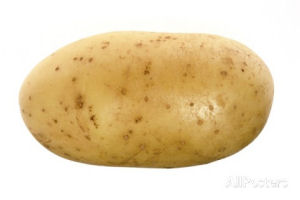
New Hampshire State Vegetable: White Potato
Prints, photographs, posters
The following information was excerpted from the State of New Hampshire Revised Statutes Online, Title 1, Chapter 3, Section 3:27.
TITLE I: THE STATE AND ITS GOVERNMENT
CHAPTER 3: STATE EMBLEMS, FLAG, ETC.
Section 3:27
3:27 State Vegetable. --The white potato is hereby designated as the official state vegetable of New Hampshire.
Source. 2013, 54:1, eff. Aug. 3, 2013.
Sources...
Leubsdorf, Ben. "Derry Representative, Fourth-graders Want Potato to Be N.H. State Vegetable." The Concord Monitor. The Concord Monitor, 4 Dec. 2012. Web. 3 Apr. 2013.
Leubsdorf, Ben. "N.H. Senate Backs Potato but Kills Bills to Decriminalize Marijuana, Ban Prison Privatization." The Concord Monitor. The Concord Monitor, 3 May 2013. Web. 4 May 2013.
O'Connor, John T. "Chaptered Law: 0054." New Hampshire General Court. State of New Hampshire, 3 Aug. 2013. Web. 23 Oct. 2016.
O'Connor, John T. "HB 535, Establishing the White Potato as the State Vegetable." HOUSE JOURNAL No. 8 (2013): 470. Web. 3 Apr. 2013.
"Potato Becomes State Vegetable, Thanks to Derry Village Students." The Nutfield News, 13, June 2013. Web. 13 Nov. 2016.
"State of New Hampshire Revised Statutes Online." New Hampshire General Court. State of New Hampshire, Aug. 2016. Web. 23 Oct. 2016.
"The Legislature May Name an Official State Potato." The Keene Sentinel. The Keene Sentinel, 27 Feb. 2013. Web. 3 Apr. 2013.
[1] True, Morgan. "NH House Approves White Potato as State Vegetable." The Boston Globe. The Boston Globe, 20 Feb. 2013. Web. 3 Apr. 2013.
Additional Information
New Hampshire Almanac >State Vegetable: The State of New Hampshire.
A Guide To Every Type Of Potato You Need To Know: Article from The Huffington Post.
Growing potatoes :
University of New Hampshire Cooperative Extension.
:
University of New Hampshire Cooperative Extension.
Potato Types: Potatoes USA, potato marketing and research organization.
Potato Facts: From the National Potato Council.
State vegetables: Complete list of official state vegetables from NETSTATE.COM.
More symbols & emblems: Complete list of official New Hampshire state symbols from NETSTATE.COM.

Potato
John Reader
Potato: A History of the Propitious Esculent, by John Reader. 336 pages. Publisher: Yale University Press (March 29, 2011)
The potato—humble, lumpy, bland, familiar—is a decidedly unglamorous staple of the dinner table. Or is it? John Reader’s narrative on the role of the potato in world history suggests we may be underestimating this remarkable tuber. From domestication in Peru 8,000 years ago to its status today as the world’s fourth largest food crop, the potato has played a starring—or at least supporting—role in many chapters of human history. In this witty and engaging book, Reader opens our eyes to the power of the potato.
Whether embraced as the solution to hunger or wielded as a weapon of exploitation, blamed for famine and death or recognized for spurring progress, the potato has often changed the course of human events. Reader focuses on sixteenth-century South America, where the indigenous potato enabled Spanish conquerors to feed thousands of conscripted native people; eighteenth-century Europe, where the nutrition-packed potato brought about a population explosion; and today’s global world, where the potato is an essential food source but also the world’s most chemically-dependent crop. Where potatoes have been adopted as a staple food, social change has always followed. It may be “just” a humble vegetable, John Reader shows, yet the history of the potato has been anything but dull.
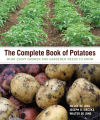
The Complete
Book of Potatoes
Hielke De Jong
Joseph B. Sieczka
Walter De Jong
The Complete Book of Potatoes: What Every Grower and Gardener Needs to Know, by Hielke De Jong, Joseph B. Sieczka, and Walter De Jong. 260 pages. Publisher: Timber Press; 1st edition (March 30, 2011)
Once viewed in Europe as an unpromising curiosity from remote highlands in South America, the potato (Solanum tuberosum) eventually became a staple food in Europe and North America, and today is the world's third largest food crop after rice and wheat. Much of the potato's global success is due to its great adaptability to widely differing, even harsh, growing environments.
In this informative account of the best potatoes for North American gardens, three scholars share their expertise in growing potatoes. Writing for gardeners, farmers, and hobbyists, the authors provide practical as well as technical information about the potato plant, its origin, conventional and organic production techniques, pest management, and storage practices. They also touch on the potato's versatility in food and nonfood uses, and the cultural relationships that have developed between potatoes and people. The plant profiles include still-life photographs of the exterior and interior of the tuber, and a succinct description of each variety's physical and culinary qualities.

300 Best Potato Recipes
Kathleen
Sloan-McIntosh
300 Best Potato Recipes: A Complete Cook's Guide, by Kathleen Sloan-McIntosh. 448 pages. Publisher: Robert Rose, Inc. (September 8, 2011)
A "desert island" vegetable if ever there was one, the potato appeals to all of us, whether in the form of traditional comfort dishes or in the guise of the new and exotic. Versatile, nutritious, inexpensive and unfailingly delicious, no other vegetable, and few foods in general, can make those claims.
Tempting possibilities are offered up in this widely varied assortment of recipes, a collection that runs the gamut from instructing on the classics -- the perfect mashed, baked, roasted and fried potatoes -- to introducing innovative, colorful and creative modern dishes.
Appetizers and snacks, soups and salads, side dishes, main courses, hearty vegetarian main dishes, baked goods and desserts make up this vast and colorful collection of recipes. The author also includes a complete history and origins of potatoes as well as a comprehensive chapter that covers hundreds of potato varieties.
And for the growing number of home vegetable gardeners, there’s even a chapter devoted to cultivating and growing your own potatoes, as well as fundamental information on storing potatoes.
The humble potato is a culinary powerhouse and inspires adventurous and tantalizing fare.
The Omnivore's Dilemma: A Natural History of Four Meals, by Michael Pollan. 464 pages. Penguin Press HC, The (April 11, 2006) The bestselling author of The Botany of Desire explores the ecology of eating to unveil why we consume what we consume in the twenty-first century
In Defense of Food: An Eater's Manifesto, by Michael Pollan. 256 pages. Penguin Press HC, The (2008) In looking toward traditional diets the world over, as well as the foods our families-and regions-historically enjoyed, we can recover a more balanced, reasonable, and pleasurable approach to food. Michael Pollan's bracing and eloquent manifesto shows us how we might start making thoughtful food choices that will enrich our lives and enlarge our sense of what it means to be healthy.

